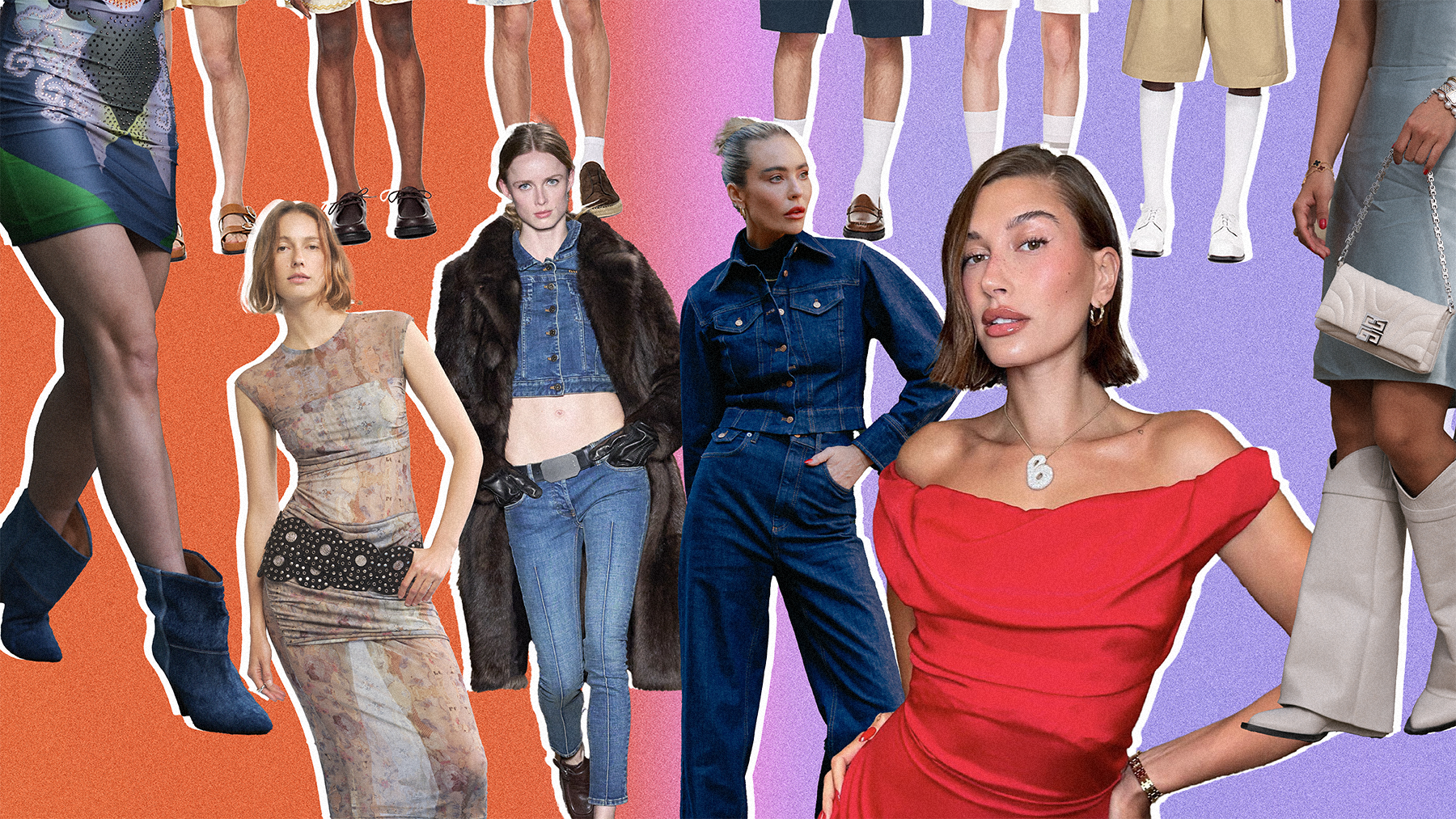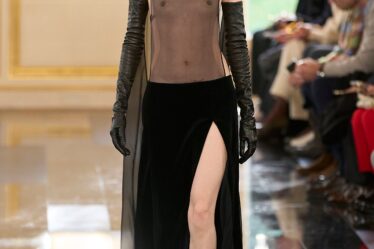
Like any other group of chronically online young people, employees of Ssense have strong opinions about the proper length of socks.
According to the memes, Millennials cannot resist stubbornly defending their no-show socks against an onslaught of mockery from Gen-Z, who prefer longer socks. But at the fashion-forward retailer, employees of both generations agreed that socks that hit the ankle or higher are indeed superior.
Rather than come down publicly on the side of crew socks, however, Ssense saw an opportunity in the controversy itself, said Steff Yotka, head of digital content for the online retailer. On Instagram, the online retailer posed the question, “What is the correct sock length?” accompanied by different styles as seen on its website, from no-show socks paired with Bode shorts to high socks complementing Willy Chavarria khaki shorts.
The post garnered over 300 comments, more than the previous seven posts combined.
“We want to find opportunities to ask our audience what they’re interested in and showcase the breadth of Ssense rather than thinking of it as either-or marketing,” said Yotka.
As Gen-Zers hit their mid-20s, the style gap between that generation and their slightly older peers is rapidly widening. The battle over skinny jeans — a Millennial mainstay — is largely over, with baggy fits now the norm. But fighting still rages over high-waisted bottoms versus low waist, a Y2K trend embraced mostly by those too young to have watched Paris Hilton on TV. Plenty of Millennials are still holding onto floral prints, ankle boots and contouring makeup, eliciting gentle ridicule from their younger siblings and colleagues.
For brands and retailers hoping to serve customers both over and under the age of 25, the viral Gen-Z versus Millennial divide presents a conundrum: How to join the latest trends without alienating older, more conservative shoppers? While Gen-Z may be inventing new styles, it’s Millennials who still hold the spending power. The average American shopper between ages 35 and 44 spent $2,632 on apparel in 2022, according to the US Bureau of Labor Statistics, more than double the cohort under 25.
The author has shared a Flourish data chart.You will need to accept and consent to the use of cookies and similar technologies by our third-party partners (including: YouTube, Instagram or Twitter), in order to view embedded content in this article and others you may visit in future.
Focusing too much on age can be a trap, marketers told BoF. The hyper-speed of the fashion cycle today means trends can come and go overnight, and that there is no longer a dominant definition of what “fashionable” looks like at any given moment. This means consumers of all ages can be exposed to any of the countless trends and fads on the internet.
Brands should not plan their assortment around how many of their customers are fashion-forward Zoomers and how many are risk-averse Millennials, trend analysts said. Instead, the key is to make products accessible to everyone through merchandising and a targeted marketing strategy.
“It’s restrictive to think of age demographics as defining [customer behaviour],” said Katy Lubin, vice president of brand and communications at Lyst, a fashion search platform. “Personal style is evolving so fast and how people choose to present themselves changes all the time.”
It’s a Gen-Z World
Given the undeniable spending prowess of Millennials today, Millennial preferences define the most popular styles on the market right now. But Gen-Z is well on its way to shaping the future.
For instance, while Millennial-approved high-waist jeans continue to be the most popular rise among retailers, accounting for 29 percent of all styles, the selection of low-rise jeans is increasing 30 percent year-on-year while the number of new high-rise options hitting the market has actually dipped 1 percent in the same period, according to market analysis data from EDITED, a retail intelligence firm.
Similarly, the Gen-Z fuelled resurgence of Y2K has brought capri pants and bubble skirts back into style, with an increase of 178 percent and 247 percent respectively in new styles year-over-year, EDITED found.
For Millennials, capri pants and bubble skirts are a blast from the past — and may bring back memories of their awkward adolescence. But this playful dynamic can become part of the conversation between a brand and its customers.
“Our brand voice is witty and funny, like we’ve communicated to customers in the past, ‘If you’re ready to say goodbye to your skinny jeans, here’s an assortment of baggy jeans,’” said Sky Pollard, head of product at Nuuly, a womenswear rental platform operated by Urban Outfitters, Inc. “We want people to rent whatever makes them comfortable.”
The majority of Nuuly subscribers are under 35, which spans older Gen-Z to younger Millennial. Like Ssense, Nuuly does not address the generational differences among its customers, instead highlighting their shared traits.
“In general, our customer is open to trying new things, and that’s part of their personality,” Pollard said.
Still, Nuuly is conscious that some trendy wares are more palatable than others. Its goal is to make new styles accessible to everyone, including less adventurous customers. Particularly edgy pieces, like a basketball jersey, for example, will often be featured in editorial campaigns that live on the website to serve inspiration.
When former wardrobe staples come back into play — Miu Miu’s Autumn/Winter 2024 collection features low-rise skinny jeans, for instance — Nuuly will reshoot product pages so these pieces can be shown in a more relevant context: skinny jeans styled with knee-high boots rather than ankle boots.
Showing Up for All Generations
The matter of age and correlating behaviour may be more relevant to how a consumer shops rather than what they buy.
For instance, beauty brand Glossier found its first set of customers a decade ago in coming-of-age Millennials who embraced the direct-to-consumer model that was disrupting the retail landscape at that time. Today, its younger Gen Z and Gen Alpha shoppers are discovering the brand through TikTok and Sephora, which began stocking Glossier last year.
“The biggest difference is how and where they encounter the brand,” Glossier CEO Kyle Leahy told BoF in an email. “When we launched into all North American Sephora doors last year, we opened the brand up to an entire new generation of shoppers and that has really helped catapult Glossier into the consciousness of younger generations.”
MeUndies too has found that a multifaceted approach to marketing is critical for reaching different segments of shoppers. For Gen-Z shoppers, the most effective channel is, unsurprisingly, TikTok, according to chief revenue officer Ariel Stoddard. For Millennials, meanwhile, the best channel is advertising in podcasts.
Ultimately, the savviest fashion companies recognise that the jabs between Millennials and Gen-Z over their respective fashion sensibilities are all in good fun.
“My Gen-Z intern cooks me daily,” said Ty Johnson, a 32-year-old DJ and marketing strategist based in Brooklyn. “What I find cool, she finds cringe and vice versa I guess. But I’m not going to start wearing Ed Hardy to try to give off a Gen-Z vibe.”



